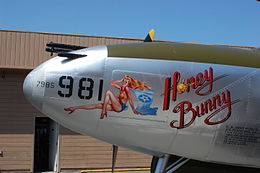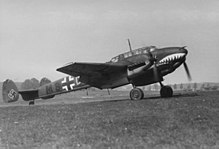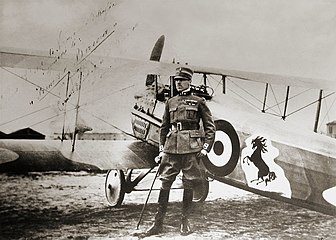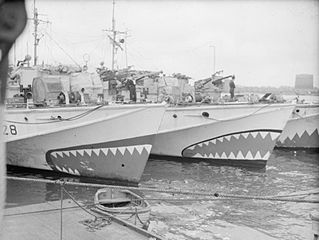Nose art


Nose artis a decorativepaintingor design on thefuselageof anaircraft,usually on the front fuselage.
While begun for practical reasons of identifying friendly units, the practice evolved to express the individuality often constrained by the uniformity of the military, to evoke memories of home and peacetime life, and as a kind of psychological protection against the stresses of war and the probability of death. The appeal, in part, came from nose art not being officially approved, even when the regulations against it were not enforced.[2][3]
Because of its individual and unofficial nature, it is consideredfolk art,inseparable from work as well as representative of a group.[2]It can also be compared to sophisticatedgraffiti.In both cases, the artist is oftenanonymous,and the art itself isephemeral.In addition, it relies on materials immediately available.[2]
Nose art is largely a military tradition, but civilian airliners operated by theVirgin Groupfeature "Virgin Girls" on the nose as part of theirlivery.In a broad sense, the tail art of several airlines such as theEskimoofAlaska Airlinescan be called "nose art", as are the tail markings of present-dayU.S. Navysquadrons. There were exceptions, including theVIII Bomber Command,301st Bomb GroupB-17F "Whizzer", which had its girl-riding-a-bomb on the dorsal fin.[4]
History[edit]
Placing personalized decorations on fighting aircraft began withItalianandGermanpilots. The first recorded example was a sea monster painted on an Italianflying boatin 1913.[citation needed]This was followed by the popular practice of painting a mouth beneath thepropeller'sspinnerbegun by German pilots inWorld War I.What is perhaps the most famous of all nose art, the shark-face insignia later made famous by the FirstAmerican Volunteer Group(AVG)Flying Tigers,first appeared in World War I on a BritishSopwith Dolphinand a GermanRoland C.II,though often with an effect more comical than menacing.[5][page needed]Thecavallino rampante( "prancing horse" ) of the ItalianaceFrancesco Baraccawas another well-known image.
World War I[edit]
World War I nose art was usually embellished or extravagantsquadroninsignia. This followed the official policy established by theAmerican Expeditionary Forces' Chief of the Air Service,Brigadier GeneralBenjamin Foulois,on 6 May 1918, requiring the creation of distinct, readily identifiable squadron insignia.[6]World War I examples include the "Hat in the Ring" of the American94th Aero Squadron(attributed to Lt. Johnny Wentworth)[6]and the "Kicking Mule" of the95th Aero Squadron.Nose art of that era was often conceived and produced not by the pilots, but rather by ground crews.
-
Eddie Rickenbackerwith SPAD XIII (note the "Hat in the Ring" 94th Aero Squadron insignia), France, 1918
-
Spad XIII pursuit aircraft of the 95th Aero Squadron with the "Kicking Mule" insignia, France, 1918
World War II[edit]

True nose art appeared duringWorld War II,which is considered by many observers[7]to be thegolden ageof the genre, with bothAxisandAlliedpilots taking part. At the height of the war, nose artists were in very high demand in theUSAAFand were paid quite well for their services, while AAF commanders tolerated nose art in an effort to boost aircrew morale. The U.S. Navy, by contrast, prohibited nose art, the most extravagant being limited to a few simply-lettered names, while nose art was uncommon in theRoyal Air ForceandRoyal Canadian Air Force.The work was done by professional civilian artists as well as talented amateur servicemen. In 1941, for instance, the39th Pursuit Squadroncommissioned aBell Aircraftartist to design and paint the "Cobrain the Clouds "logoon their aircraft.[8]
Perhaps the most enduring nose art of World War II was the shark-facemotif,which first appeared on theMesserschmitt Bf 110sofLuftwaffeZerstörergeschwader 76( "76th Heavy Fighter Wing" ) overCrete,where the twin-engined Messerschmitts outmatched theGloster Gladiatorbiplanes ofNo. 112 Squadron RAF.[citation needed]The Commonwealth pilots were withdrawn to Egypt and refitted withCurtiss Tomahawks(P-40) off the same assembly line building fighter aircraft for theAmerican Volunteer Group(AVG)Flying Tigersbeing recruited for service inChina.In November 1941, AVG pilots saw a color photo in a newspaper of a shark mouth painted on a 112 Squadron P-40 fighter inNorth Africaand immediately adopted the shark-face motif for their own P-40Bs.[9]The British version itself was inspired by "sharkmouth" nose art (without any eyes) on the Messerschmitt Bf 110 heavy fighters ofZerstörergeschwader 76.This work was done by the pilots and ground crew in the field.[10]However, the insignia for the "Flying Tigers" – a wingedBengal tigerjumping through a stylizedV for Victorysymbol – was developed by graphic artists from theWalt Disney Company.[11]
Similarly, when in 1943 the39th Fighter Squadronbecame the first Americansquadronin theirtheatrewith 100 kills, they adopted the shark-face for theirLockheed P-38 Lightnings.[8]The shark-face is still used to this day, most commonly seen on theFairchild Republic A-10 Thunderbolt II(with its gaping maw leading up to the muzzle of the aircraft's GAU-8 Avenger 30mm cannon), especially those of the23d Fighter Group,the AVG's descendent unit, and a testament to its popularity as a form of nose art.

The largest known work of nose art ever depicted on a World War II-era American combat aircraft was on aConsolidated B-24 Liberator,tail number44-40973,which had been named "The Dragon and his Tail" of the USAAFFifth Air Force64th Bomb Squadron,43d Bomb Group,in theSouthwest Pacific,flown by a crew led by Joseph Pagoni, with Staff Sergeant Sarkis Bartigian as the artist. The dragon artwork ran from the nose just forward of the cockpit, down the entire length of the fuselage's sides, with the dragon's body depicted directly below and just aft of the cockpit, with the dragon holding a nude woman in its forefeet.[12][13]

Tony Starcerwas the resident artist for the91st Bomb Group (Heavy),one of the initial six groups fielded by theEighth Air Force.Starcer painted over a hundred pieces of renowned B-17 nose art, including"Memphis Belle".[14][15]A commercial artist named Brinkman, fromChicagowas responsible for thezodiac-themed nose art of theB-24 Liberator-equipped834th Bomb Squadron,based atRAF Sudbury,England.[16]
Contemporary research demonstrates that bomber crews, who suffered high casualty rates during World War II, often developed strong bonds with the planes they were flying, and affectionately decorated them with nose art.[17][18]It was also believed by the flight crews that the nose art was bringing luck to the planes.[19]
The artistic work ofAlberto VargasandGeorge Petty's pin-up girls fromEsquireMagazine were often duplicated, or adapted, by air force crews and painted on the nose of American and allied aircraft during World War II.
Some nose art was commemorative or intended to honor certain people, such as theBoeing B-29 Superfortress"TheErnie Pyle".[20]
Post-World War II[edit]

In theKorean War,nose art was popular with units operatingA-26 Invaderand B-29 bombers,C-119 Flying Boxcartransports, as well as USAFfighter-bombers.[21]Due to changes in military policies and changing attitudes toward the representation of women, the amount of nose art declined after the Korean War.
During theVietnam War,Lockheed AC-130 gunshipsof theU.S. Air Force Special Operations Squadronswere often given names with accompanying nose art – for example, "Thor", "Azrael – Angel of Death", "Ghost Rider", "War Lord" and "The Arbitrator."[22]The unofficial gunship badge of a flying skeleton with aMinigunwas also applied to many aircraft until the end of the war and was later adopted officially. In addition, Army and Navy helicopter crews often embellished their assigned aircraft with a wide range of nose art and other personalized markings.[23]

Nose art underwent a revival during theGulf Warand has become more common sinceOperation Enduring Freedomand theIraq Warbegan. A-10 Thunderbolt II aircraft ladder doors are frequentlypaintedwhile many fixed and rotary air crews are merging artwork as part of camouflage patterns. The United States Air Force had unofficially sanctioned the return of the pin-up (albeit fully clothed) with theStrategic Air Commandpermitting nose art on its bomber force in the Command's last years. The continuation of historic names such as "Memphis Belle"was encouraged.
In many other cases at airfields throughout the Middle East during theWar on terror,aviation units instead painted the reinforced concreteT-walls and Bremer barriersthat protected the aircrews and aircraft with elaborate murals and graffiti.
Regional variation[edit]
Source material for American nose art was varied, ranging frompinupssuch asRita HayworthandBetty Grableandcartooncharacters such asDonald Duck,Bugs Bunny,andPopeyeto patriotic characters (Yankee Doodle) and fictional heroes (Sam Spade). Lucky symbols such asdiceandplaying cardsalso inspired nose art, along with references to mortality such as theGrim Reaper.[2]Cartoons and pinups were most popular among American artists, but other works included animals, nicknames, hometowns, and popular song and movie titles. Some nose art and slogans expressed contempt for the enemy, especially of their leaders.
The farther the planes and crew were from headquarters or from the public eye, the racier the art tended to be.[2]For instance, nudity was more common in nose art on aircraft in thePacificthan on aircraft inEurope.[24]

Luftwaffeaircraft did not often display nose art, but there were exceptions.[25][page needed]For example,Mickey Mouseadorned aCondor LegionMesserschmitt Bf 109during the Spanish Civil War and one Ju 87A was decorated with a large pig inside a white circle during the same period.Adolf Galland's Bf-109E-3 ofJG 26also had a depiction of Mickey Mouse, holding acontemporary telephonein his hands, in mid-1941. A Ju 87B-1 (Geschwaderkennungof S2+AC) of Stab II/St. G 77, piloted by Major Alfons Orthofer and based inBreslau-Schöngartenduring theinvasion of Poland,was painted with a shark's mouth, and some Bf 110s were decorated with furious wolf's heads, stylisticwasps(as withSKG 210andZG 1), or as in the case ofZG 76,the shark mouths that inspired both the RAF's 112 Squadron and in turn the Flying Tigers in China, on their noses or engine covers. Another example wasErich Hartmann's Bf-109G-14, "Lumpi", with an eagle's head. The fighter wingJagdgeschwader 54was known as theGrünherz(Green Hearts) after their fuselage emblem, a large green heart. The Geschwader was originally formed inThüringen,nicknamed "the green heart of Germany". Perhaps the flashiest Luftwaffe nose art was the red and whitevipersnake insignia running through the whole fuselage of certainJunkers Ju 87Stukadive bombers that served with the IIGruppe,and especially the 6.StaffelofSturzkampfgeschwader 2inNorth Africa campaign,the only known artwork on an Axis-flown combat aircraft that could have rivaled the length of that on "The Dragon and his Tail" B-24.
TheSoviet Air Forcesdecorated their planes with historical images, mythical beasts, and patrioticslogans.
The attitude of theFinnish Air Forceto the nose art varied by unit. Some units disallowed nose art, while others tolerated it. Generally, the Finnish airforce nose art was humorous or satirical, such as the "horned Stalin" on Maj. Maunula'sCurtiss P-36fighter.
TheJapan Air Self-Defense Forcehas decorated fighter aircraft withValkyrie-themed characters under the namesMystic EagleandShooting Eagle.[26]
Beginning in 2011, theJapan Ground Self-Defense ForcehasAH-1S Cobraanti-tank helicopters andKawasaki OH-1observation helicopter namedIta-CobraandIta-Omegarespectively, decorated in the theme of 4Kisarazu( mộc canh tân ) sisters (Akane ( mộc canh tân thiến ), Aoi ( mộc canh tân quỳ ), Wakana ( mộc canh tân nhược thái ), Yuzu ( mộc canh tân dữu tử )).[27]The Aoi-chan first appeared in 2011, followed by the other three sisters in 2012.[28][29]
Canadian Forceswere reported having nose art onCH-47D ChinookandCH-146 Griffonhelicopters inAfghanistan.[30]
Famous examples[edit]

- Pierre Clostermann'sHawker TempestLe Grand Charlesfeatured theCross of Lorraine.
- Brendan Finucane's Spitfires wore ashamrockwith a "B" within it. Ireland's top ace in World War Two also was the youngestwing commanderin Royal Air Force history.
- Adolf Gallandwas famous for paintingMickey Mouseon his aircraft, and the mascot was adopted by hisGruppeduring the early airwar phase ofWorld War II.
- Don Gentile'sNorth American P-51 Mustangnamed "Shangri-La", with an eagle sporting boxing gloves.
- Ian Gleed'sHawker HurricanesandSupermarine Spitfirefeatured Figaro the Cat, from the 1940 Disney animated moviePinocchio.
- Erich Hartmann's Bf 109s featured a distinctive "black tulip" design on the very front of thecowling,immediately behind the spinner.
- Johnny Johnson'sSupermarine SpitfireMk.IX featured the Canadianmaple leaf.
- John D. Landers' P-51D, which sported a distinctive black-and-white checkerboard with red trim.
- Ted W. Lawson,who (along with journalistBob Considine) famously wrote about the 1942Doolittle RaidinThirty Seconds Over Tokyo,piloted aNorth American B-25 Mitchellbomber nicknamedThe Ruptured Duck,after a minor training accident in which theaircraft tail scraped the groundduring takeoff; this was decorated by acaricatureof an angryDonald Duckfigure with crutches and wearing a pilot's headphones.
- James MacLachlan,who flew with an artificial arm, had his Hawker Hurricane adorned with a picture of his amputated arm giving aV sign
- Werner Möldersflew a yellow-nosedMesserschmitt Bf 109F-2while withJG 51during June 1941.
- Chuck Yeager's series of aircraft named "Glamorous Glennis", with bright letter art.
The markings of aces were often adopted by their squadrons, such as Galland's Mickey Mouse and Hartmann's black tulip (still in use until recently on the aircraft ofJG 71 "Richthofen"– not known to be in use on the unit's newEurofighter Typhoons).
Similar art[edit]
Designs similar to aviation nose art could be found during World War II on some British torpedo boats, and German and US submarines. Similar designs can also be found on someHIMARS-equippedFMTVsin the service of theArmed Forces of Ukraineduring theRussian invasion.
-
Royal NavyMotor Torpedo Boatsdecorated with shark mouths, June 1944
-
A captured GermanBibermidget submarinewith a shark-mouth design
-
USSTorsk,a World War II submarine, now one of theHistoric Ships in Baltimore
Regulation[edit]
United States[edit]
In 1993 the United States Air Force Air Mobility Command ordered that all nose art should be gender-neutral.[31]
A 2015 US Air Force memorandum stated that nose art must be "distinctive, symbolic, gender neutral, intended to enhance unit pride, designed in good taste." Furthermore, it must not contravene copyright and trademark laws.[32]
See also[edit]
- Aircraft livery
- Victory marking,a similar practice often applied on the aircraft's nose
References[edit]
- ^"Flying high for 34 years – 10 facts about our flying lady nose art | Stories | Virgin Atlantic".flywith.virginatlantic.com.Retrieved2024-02-21.
- ^abcde"Military Aircraft Nose Art".Retrieved30 December2014.
- ^Ethell, Jeffrey L. (1991). The History of Aircraft Nose Art: World War I to Today.Osceola, Wisconsin: Motorbooks International, p. 14.
- ^Bowers, Peter M. (1976).Fortress In The Sky,Granada Hills, CA: Sentry Books.ISBN0-913194-04-2,p. 219.
- ^Ward, Richard.Sharkmouth, 1916–1945.New York: Arco, 1979.
- ^ab"Air Force Historical Research Agency".Retrieved30 December2014.
- ^"Nose Art – The Most Unique Art by Pilots During WWII".DailyArt Magazine.2022-02-08.Retrieved2022-05-17.
- ^ab"Military Flying, CHOCKIE 39th History".Retrieved30 December2014.
- ^Rossi, Dick (1980s)."A Flying Tigers Story".The Flying Tigers – American Volunteer Group – Chinese Air Force.
- ^Ford, Daniel.Flying Tigers: Claire Chennault and His American Volunteers, 1941–1942.Washington, DC: Harper Collins–Smithsonian Books, 2007, pp. 82–83.
- ^Eisel, Braxton.The Flying Tigers: Chennault's American Volunteer Group in China.Washington, DC: Air Force History and Museums Program, 2009.
- ^"From the 64th Squadron Briefing Room".Retrieved30 December2014.
- ^"From the 64th Squadron Briefing Room".Retrieved30 December2014.
- ^"Tony Starcer – Nose Artist – 91st BG".Retrieved30 December2014.
- ^Mark Bowden."USAAF Nose Art Research Project – Named planes of the USAAF during WWII".Retrieved30 December2014.
- ^Valant, Gary M. Classic Vintage Nose Art. Ann Arbor, Michigan: Lowe and B. Hould, 1997, pp. 13–15.
- ^Pfau, Ann Elizabeth. Miss Yourlovin: GIs, Gender and Domesticity During World War II. New York: Columbia University Press, 2008. Available at Gutenberg-e, a program of the American Historical Association and Columbia University Press:[1]
- ^Banker, Franklin (June 11, 1944)."U.S. bombers stripped of captivating nudes".Lewiston Morning Tribune.(Idaho). Associated Press. p. 7.
- ^Polmar, Norman, and Thomas B. Allen. World War II: The Encyclopedia of the War Years, 1941–1945. New York: Random House, 1996, p. 595.
- ^Superfort "Ernie Pyle", Gift of Plane Plane Workers, Here En Route to JapanPDFArchived2011-07-08 at theWayback Machine
- ^Thompson, Warren E. Heavy Hauler.Wings of Fame, The Journal of Classic Combat Aircraft,Volume 20. London: Aerospace Publishing Ltd., 2000, p. 107.
- ^Olausson, Lars.Lockheed Hercules Production List – 1954–2011,27th ed. Såtenäs, Sweden, 2009. (Self-published.)
- ^Brennan, John (2017).Vietnam War Army Helicopter Nose Art.United Kingdom.ISBN978-1-62545-035-7.OCLC1002121376.
{{cite book}}:CS1 maint: location missing publisher (link) - ^Cohan, Phil. "Risque Business." Air and Space, 5 (Apr.–May 1990), p. 65.
- ^Ketley, Barry.Luftwaffe emblems.Manchester: Flight Recorder Publications, 2012.
- ^"Noseart – Works".Retrieved30 December2014.
- ^"The Four Sisters of the Fourth Anti-Tank Helicopter Squad are Celebrated One Last Time!".14 June 2013.
- ^"The Japanese Military Is Getting Offensively Cute".13 April 2015.
- ^"Japan's Armed Forces Show Their Playful Side: Moé-Style Attack Helicopter Wows Crowds".19 October 2012.
- ^"Canadian chopper crews revive nose-art tradition in Afghanistan".Asian Defence. 7 April 2009.Retrieved30 December2014.
- ^Military Airplanes Get New Gender-neutral Look,Steve Fide, Deseret News, July 19, 1993.
- ^"Aircraft Nose Art Makes Quiet Comeback, Reviving Air Force Tradition".Military.com.2017-10-31.Retrieved2022-06-29.
Bibliography[edit]
- Bloomfield, Gary L., Stacie L. Shain, & Arlen C. Davidson.Duty, honor, applause: America's entertainers in World War II.Guilford, CN: Lyon's Press, 2004.ISBN1-59228-550-3.(pp. 400–405 discuss pin-up girl and nose art.)
- Bredau, Robert (1989).The Meaning of Nose Art: An Anthropological Perspective(Thesis). California State University.
- Campbell, John M. & Campbell, Donna.War paint: fighter nose art from WWII & Korea.Osceola, WI: Motorbooks International, 1990.
- Chinnery, Philip.50 years of the desert boneyard:Davis MonthanA.F.B., Arizona.Osceola, WI: Motorbooks, International, 1995.
- Cohan, Phil. "Risque Business."Air and Space5 (Apr.–May 1990): 62–71.
- Davis, Larry.Planes, Names and Dames: 1940–1945.Vol. 1. Carrollton, TX: Squadron/Signal Publications, 1990.
- Davis, Larry.Planes, Names and Dames: 1946–1960.Vol. 2. Carrollton, TX: Squadron/Signal Publications, 1990.
- Davis, Larry.Planes, Names and Dames: 1955–1975.Vol. 3. Carrollton, TX: Squadron/Signal Publications, 1990.
- Dorr, Robert F.Fighting Colors: Glory Days of U.S. Aircraft Markings.Osceola, WI: Motorbooks International, 1990.
- Ethell, Jeffrey L.The History of Aircraft Nose Art: World War I to Today.Osceola, WI: Motorbooks International, 1991.
- Ford, Daniel.Flying Tigers: Claire Chennault and His American Volunteers, 1941–1942.Washington, DC: HarperCollins–Smithsonian Books, 2007.ISBN0-06-124655-7.
- Fugere, Jerry.Desert Storm B-52 Nose Art.Tucson, AZ: J. Fugere, 1999.
- Ketley, Barry.Luftwaffe emblems.Manchester: Flight Recorder Publications, 2012.
- Logan, Ian.Classy Chassy.New York: W. W. Visual Library, 1977.
- March, Peter R.Desert Warpaint.London: Osprey Aerospace, 1992.
- McDowell, Ernest R.The P-40 Kittyhawk at War.New York: Arco Publishing, 1968.
- O'Leary, Michael D. "Disney Goes to War!"Air Classics32, no. 5 (1996): 40–42, 45–51.
- Schellinger, Andretta F. "Aircraft Nose Art: American, French, and British Imagery and its influence from World War I through the Vietnam War", Jefferson, NC: McFarland, 2015ISBN9780786497713.
- Schellinger, Andretta F.From Knights to Skulls: The Cultural Evolution of Nose Artwork.The Dalles, OR: Schellinger Research Publishing, 2013.ISBN978-1493606375.
- Tullis, Thomas A.Tigers over China: camouflage, markings, and squadron insignia of the American Volunteer Group's aircraft in China, 1941–42.Hamilton, MT: Eagle Editions, 2001.
- Valant, Gary M.Classic Vintage Nose Art.Ann Arbor, MI: Lowe and B. Hould (an imprint of Borders, Inc.), 1997.ISBN0-681-22744-3.
- Velasco, Gary.Fighting Colors: The Creation of Military Aircraft Nose Art.Turner Publishing, 2004.
- Walker, Randy.Painted Ladies.West Chester, PA: Schiffer Publishing, 1992.
- Walker, Randy.More painted ladies: modern military aircraft nose-art & unusual markings.Atglen, PA: Schiffer Publishing, 1994.
- Ward, Richard.Sharkmouth, 1916–1945.New York: Arco, 1979.
- Wayland, Kent (2014). ""It's Not an Airplane, It's My Baby": Using a Gender Metaphor to Make Sense of Old Warplanes in North America ". In Lipset, David; Handler, Richard (eds.).Vehicles: Cars, Canoes, and Other Metaphors of Moral Imagination(First Paperback ed.). New York: Berghahn Books. pp. 69–87.ISBN9781782383765.Retrieved2 March2020.
- Wesemann, Terri (2019).Metal Storytellers: Reflections of War Culture in Silverplate B-29 Nose Art from the 509th Composite Group(Thesis). Utah State University.Retrieved2 March2020.
External links[edit]
- Don Allen's Art[dead link]
- USAAF Nose Art Research Project
- Nose art history and replica panels
- Nose art galleryArchived2016-04-22 at theWayback Machine
- Nose art of World War II airplanes.
- nose artat the International Bomber Command Centre Digital Archive.






